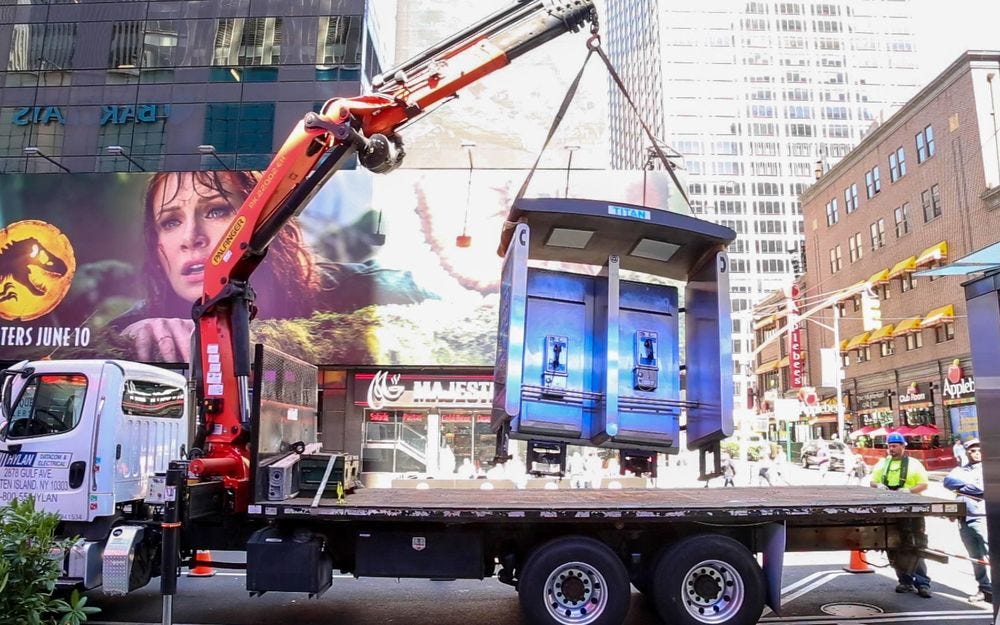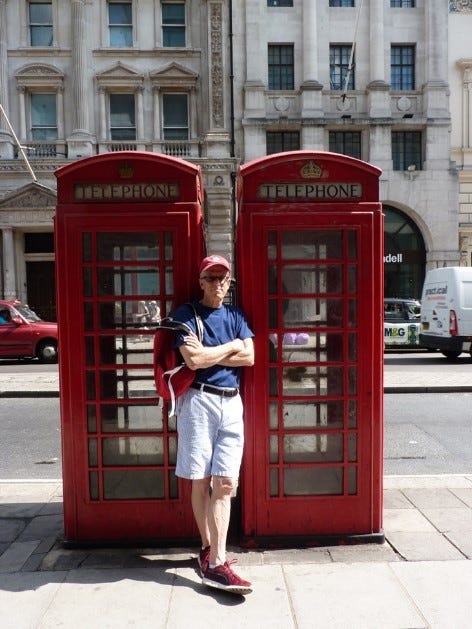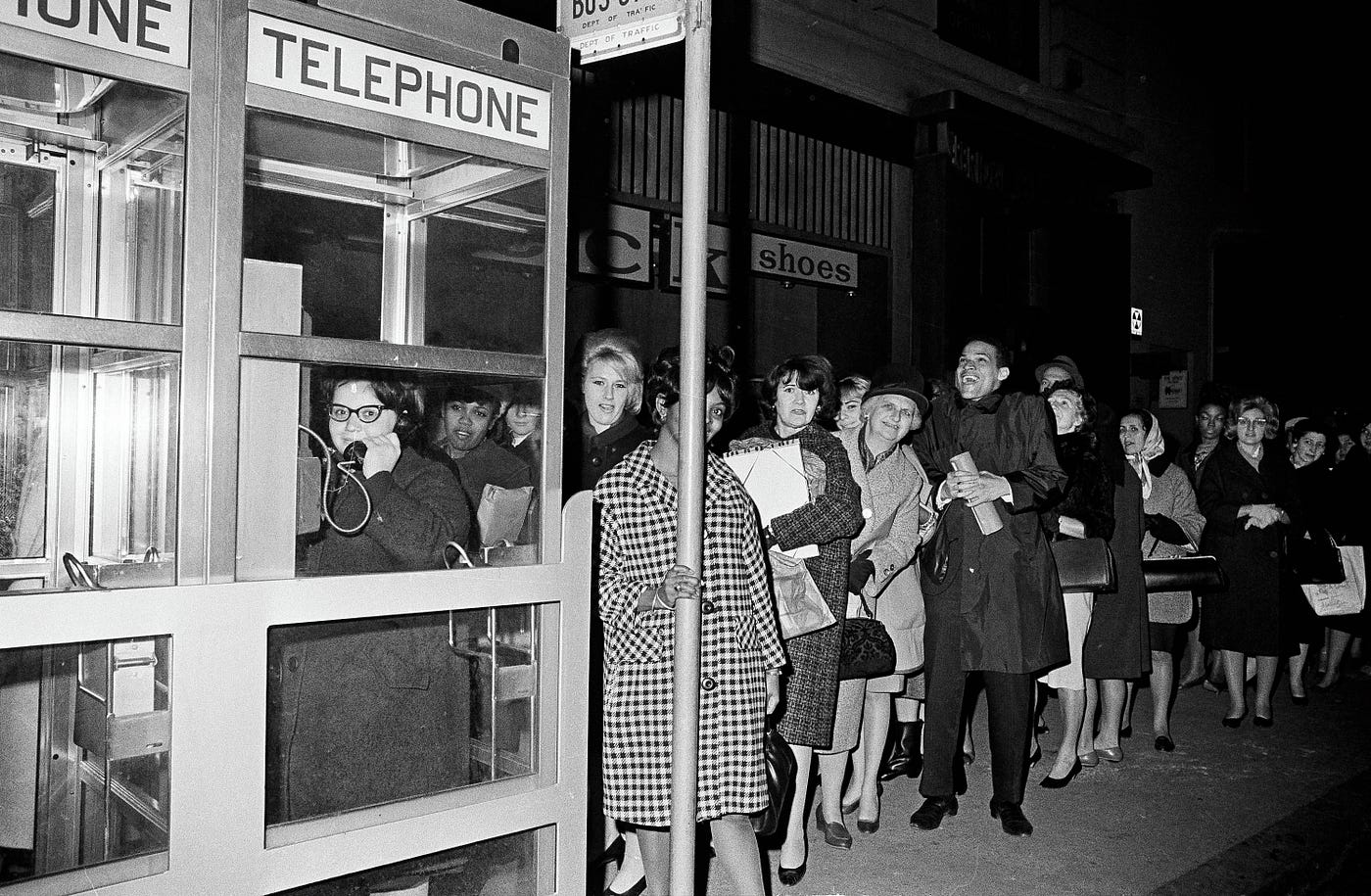

Good Bye, Phone Booth — We Don’t Really Need You Any More
source link: https://mjhoban.medium.com/good-bye-phone-booth-we-dont-really-need-you-any-more-4472c5410109
Go to the source link to view the article. You can view the picture content, updated content and better typesetting reading experience. If the link is broken, please click the button below to view the snapshot at that time.
Good Bye, Phone Booth — We Don’t Really Need You Any More

Image by CityBridge
“Operator…you’ve been so much more than kind; you can keep the dime.” (From 1972 song “Operator” by Jim Croce)
Last month New York City’s last remaining public phone booth was removed and hauled away to become a museum exhibit. It’s the end of a technical and cultural touchstone and it leaves Superman without a place to change into his red/yellow/blue super attire.
Superman is not the only one who made extensive use of the phone booth over the years, though. In 1960, AT&T reported that it installed its one millionth phone booth in the U.S. and it’s estimated there were upwards of two million at the peak of its functionality, which was probably the early 1970s.
But with the changing of the times and of the technology, phone booths began to go away. And it’s not just in the U.S. Denmark reportedly yanked out its last phone booth in 2017 and Belgium’s last one was removed in 2015. The U.K. — and especially London — will likely leave some of their iconic red phone “boxes” (they don’t call them booths) in operation because of the charm and tourism factor. It’s amazing how many Americans cozy up for a cheesy photo shot in front of one of those red booth/boxes. Like the guy pictured here.

Who among you readers who are over 40 has not used a phone booth or a pay phone at some point in your lives?
Phone booths use to be everywhere, it seems. I grew up in Detroit and could not pass a phone booth on the street without checking for coins in the coin return that someone might have left behind. It was one quick motion to pull down the coin return receptacle and swipe your finger in the smooth, curved return and it would become a very good day if there were some coins for the taking.
On the other hand, it became a very bad day once when I did the finger swipe for coins and encountered a pool of spit that some merry prankster had left there for coin searching kids like me. It still grosses me out just thinking about it.

Image by Best Buy
Pay phones in those booths would have three different coin slots: nickel; dime; quarter. Putting the right coin in each slot generated a different sound tone which is how the phone company knew a user was paying correctly for a call.
When phone booths and pay phones were first invented back in the early 1900s there was an attendant present who would ensure that the caller would pay for his/her call. Soon, the advancing technology of “smart” phones using those coin tones eliminated the need for attendants and thus displaced those workers. Not the first time and obviously not the last time that automation reduced the need for telephone-related occupations.
The phone booth was also a safe and secure place where teenage boys could call their teenage girlfriends and stay on a call as long as they wanted since that thin dime for the call let you chat for an unlimited amount of time. I speak from personal experience on that matter.
Pay phones — usually housed in phone booths — were also an important fixture for calling mom or dad to pick you up from school or from sports practice, especially the old “calling collect” trick. Calling “collect” is something that members of today’s younger generations will never have to master. There was the expensive person-to-person collect call done through the operator which could be accepted or rejected and there was the less expensive station-to-station, a call that simply went to the receiving line regardless of who answered.
“Hacking” the person-to-person call protocol became an art form and people from all walks of life learned how to place “free” person-to-person calls. For truck drivers on the road who wanted to let their spouse know where they were, they would use an agreed-upon fake name and when the operator asked the receiving party if they would accept a call from so-and-so from a payphone in Iowa City the spouse would say “no” but would now know their on-the-road spouse was in Iowa City. No charge. Thanks, Ma Bell.
Similarly, if you were a student and baseball practice or the swim lesson was finished and you wanted to be picked up by a parent, one could call collect and the wise parent would reject the collect call and would know that it was time to pick up the kid. Why spend the dime for the call when you could do it via the faux collect call?
In addition to the Superman connection, the phone booth has played its part as part of popular culture in movies and songs over the years. It provided a vehicle for the Bob and Ted films of the 80s and 90s to have their excellent adventures. Also notable was a 2002 thriller called Phone Booth in which Colin Farrell’s character was trapped in a phone booth by a sniper who said he would shoot him if the line got disconnected. A lighter phone booth movie connection was a brief scene in the classic “Airplane” movie.
Harry Potter fans also know that dialing 62442 (MAGIC) from a red “phone box” in London’s King’s Cross connects you to the Ministry of Magic. And of course, super-spy Maxwell Smart would use a phone booth to get him to the spy agency headquarters.
The pay phone booth had a mention in many songs including “Memphis” (“Long distance information get in touch with my Marie…”), “Payphone” by Maroon 5, Dr. Hook’s “Sylvia’s Mother” ( “And the operator says, ’40 cents more for the next 3 minutes…’”) and the Jim Croce song excerpted at the top of this piece.
There was also a period in the 1950s when phone booth stuffing was the rage on college campuses. The objective was to see how many bodies could fit inside a phone booth.
Image by Wordpress.com
The record is still held by 25 students who found a way to get themselves into a single phone booth in Durban, South Africa in 1959. There is no information about how long it took to get themselves untangled and out of the booth.
I was thinking that perhaps there might be a market for renting out old phone booths to be used for booth stuffing as a corporate team building activity to see which team can get the most people in a booth. But then again, HR staffs would likely veto such an activity because it would entail too much touching and close contact. Forget that idea.
For management training sessions held in hotels back in the 1990s and early 2000s, I remember well that session participants would rush to the hotel payphones in phone stalls at the breaks to pick up and deliver their voice messages. Back then, voice mail was a communication vehicle between people because text messaging was not a thing yet and people didn’t check email regularly. It was not unusual to dial into your voice mailbox and discover that you had 15–20 new messages, some of them long and overly verbose.
Unlike today when voicemail is used almost exclusively for missed phone calls, back then it was a preferred way to communicate and was seen as a more personal touch than email. So, at breaks and at lunch, many training session participants would dial into their 800-number mailbox from payphones (no coins necessary) and message asymmetrically with others. Messages would often bounce back and forth multiple times until it might become necessary to actually call the other party and handle the matter in real-time.
As a trainer, it was a constant frustration to see that many of the participants were not back from breaks or lunch on time and there were a number of occasions when I had to walk to the payphone area and motion them back into the room like a high school teacher catching the students smoking in the bathroom.
Many team members and managers also had pagers in that era and a paged message could send someone scurrying to a payphone to respond. Yes, prehistoric times were so different from now.
Airports were another place where businesspeople would park themselves at the payphones to check voicemail while waiting for flights. Of course, there were more people wanting to use the phones than there were phones, so it was not unusual to see people waiting in line for their turn and gnashing their teeth while the phone user was leaving multiple long-winded messages. It wasn’t quite like the picture here but you get the idea.

Image by NPR
There are still pay phones in most airports but I almost never see anyone using them on those rare occasions these days when I’m at airports. I’m not even sure if they accept coins anymore. Payphones and stalls are also still used in prisons (no personal experience) and in rural areas where cell coverage might be spotty. While payphones still play a functional .role it’s unclear how many of those phones are housed in actual phone booths. These days pay phones might just be attached to a wall, affording callers little privacy.
There’s not an agency or a business that tracks the number of phone booths. But one can bet there will be fewer next year and fewer still the year after that.
So, yes, it is the end of an era and phone booths will soon be simply part of a large collection of devices from yesteryear. When life was “different.” Quainter, perhaps. But it’s all just part of the life cycle of technology. I can wax nostalgic about them and how they were part of my growing up years but I can say it’s been at least 15 years since I used a pay phone (with a credit card) and probably 40 years since I was in a phone booth to place an actual call.
And full disclosure — Yes, the London picture with me in front of a red box was just a corny street photo — a prop — required of all visiting Americans. I didn’t have to use the phone and probably wouldn’t have known how.
About the author: Mike Hoban is a business topics writer and leadership coach/ advisor. He is actively working at becoming a world-class grandpa to his five young granddaughters. In addition to his 35+ years experience as a leader, consultant, and business owner he has also published extensively in Fast Company and wrote many thought leadership pieces for DDI when he was there. He also wrote a business column for 12 years. His recent commentaries — including many about leading during the COVID pandemic — can be found on his LinkedIn page: https://www.linkedin.com/in/mike-hoban-b5756b6/ He can also be reached at [email protected].
Recommend
About Joyk
Aggregate valuable and interesting links.
Joyk means Joy of geeK